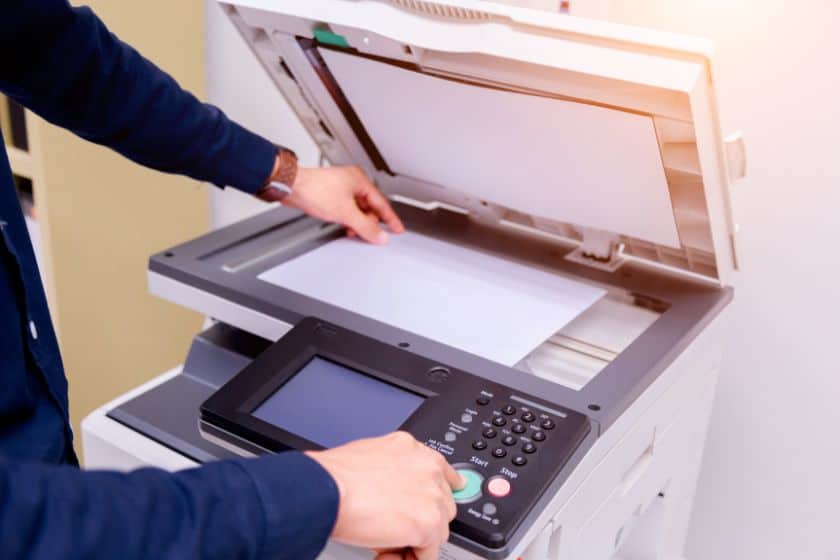 How do laser printers work? Laser printers are widely used in both homes and businesses for high-quality printing. They employ advanced technology to produce crisp, sharp prints quickly and efficiently. In this article, we will delve into the workings of laser printers, the printing process, the benefits they offer, and where you can buy laser printers for your specific needs.
How do laser printers work? Laser printers are widely used in both homes and businesses for high-quality printing. They employ advanced technology to produce crisp, sharp prints quickly and efficiently. In this article, we will delve into the workings of laser printers, the printing process, the benefits they offer, and where you can buy laser printers for your specific needs.
-
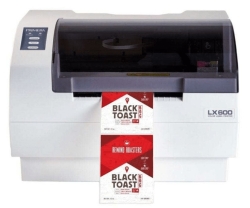 Primera LX600 Color Label Printer SKU: LX600$1,995.00
Primera LX600 Color Label Printer SKU: LX600$1,995.00
FREE SHIPPING over $199*
Orders before 12PM EST usually Ship Same Business Day - Product on sale
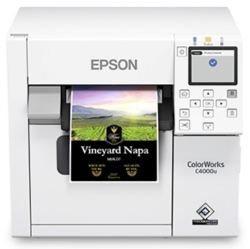 Epson C4000/CW-C4000 ColorWorks Inkjet Label Printer (Gloss) SKU: C31CK03A9991Original price was: $2,399.00.$2,199.00Current price is: $2,199.00.
Epson C4000/CW-C4000 ColorWorks Inkjet Label Printer (Gloss) SKU: C31CK03A9991Original price was: $2,399.00.$2,199.00Current price is: $2,199.00.
FREE SHIPPING over $199*
Orders before 12PM EST usually Ship Same Business Day -
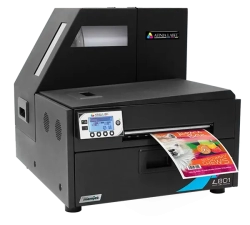 Afinia L801 Plus Commercial Color Label Printer SKU: 32498$8,495.00
Afinia L801 Plus Commercial Color Label Printer SKU: 32498$8,495.00
FREE SHIPPING over $199*
Orders before 12PM EST usually Ship Same Business Day
How Does a Laser Printer Work?
Laser printers follow a complex process involving several steps to create printed documents. Understanding the workings of laser printers can help you appreciate their efficiency and the quality of their output. Here’s a summary of how laser printers work:
The Seven Laser Printing Steps
Step 1: Sending
The printing process begins when the user sends a print command from their computer or device to the laser printer. The printer receives the data and prepares to initiate the printing process.
Step 2: Cleaning
Before printing, the laser printer cleans its internal components to ensure optimal performance. Laser printers produce a residue that settles on the drum. The previous print job needs to be removed from the photosensitive drum, and it needs to be electrically and physically cleaned in order to prepare it for the new print job.
When the drum is being cleaned, a rubber cleaning blade scrapes the toner residue off the drum and deposits it in a debris chamber. Electrostatic erase lamps found within laser printers neutralize electrical charges left over from the previous print job on the drum.
The heat roller is then lubricated to make sure that enough heat is adequately distributed to transfer the incoming image.
Step 3: Conditioning
In the conditioning step, the printer’s primary corona wire charges the photosensitive drum with a uniform negative electrostatic charge. The heat roller is then lubricated to make sure that enough heat is adequately distributed to transfer the incoming image. The heat roller is then lubricated to make sure that enough heat is adequately distributed to transfer the incoming image.
Step 4: Exposing
Now, the laser printer’s laser beam scans across the surface of the photosensitive drum. The digital image data that the computer sends serves as the laser’s control signal. As the laser hits the drum’s surface, it neutralizes the negative charge in specific areas, creating a pattern that corresponds to the image or text being printed.
Step 5: Developing
After exposure, the drum moves through a reservoir of toner particles. The toner particles are negatively charged, allowing them to adhere to the areas on the drum where the laser neutralized the charge. 85–95% of toner is made of finely ground plastic. In addition to colored pigments and fumed silica, toner contains control agents and colored pigments.
The presence of silica prevents the toner particles from adhering and clumping. Also, it facilitates a smooth transition of toner from the printer’s cartridge. An electrostatic control agent, such as zinc, iron, or chromium, maintains the negative charge of toner particles. This process forms a visible image on the drum.
-
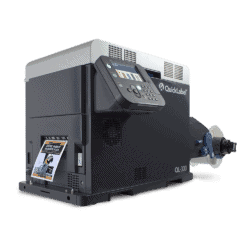 Quick Label QL-300 (120V) Toner CMYK Color Label Printer SKU: 1003-0000002$9,495.00
Quick Label QL-300 (120V) Toner CMYK Color Label Printer SKU: 1003-0000002$9,495.00
FREE SHIPPING over $199*
Orders before 12PM EST usually Ship Same Business Day -
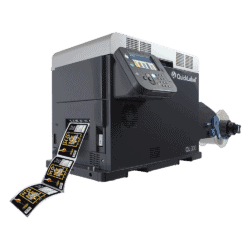 Quick Label QL-300s (120V) Toner CMYK + White Color Label Printer SKU: 1003-0000004$12,495.00
Quick Label QL-300s (120V) Toner CMYK + White Color Label Printer SKU: 1003-0000004$12,495.00
FREE SHIPPING over $199*
Orders before 12PM EST usually Ship Same Business Day -
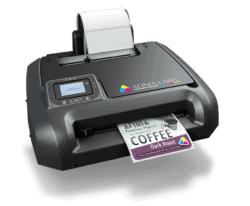 Afinia L301 Small Business Color Label Printer SKU: 26849 GTIN: 678621130057$1,249.00
Afinia L301 Small Business Color Label Printer SKU: 26849 GTIN: 678621130057$1,249.00
FREE SHIPPING over $199*
Orders before 12PM EST usually Ship Same Business Day
Step 6: Transferring
The drum makes contact with a piece of paper while still carrying the toner image. The paper’s back is given a positive charge, which causes the toner, which is negatively charged, to transfer to the paper’s surface. The toner adheres to the paper due to its electrostatic charge.
Step 7: Fusing
In the final step, the printed paper passes through the fuser unit, which consists of heated rollers. The toner particles are permanently bonded to the paper by the rollers’ heat and pressure. This creates a durable, smudge-resistant printout.
What is the History of Laser Printers
The technology for laser printers was developed in the 1950s and 1960s as a result of dot-matrix printers and mimeograph machines.
Who Was the Laser Printer’s Inventor?
In 1957, IBM invented the dot-matrix printer, and two years later, Xerox unveiled the first photocopy.
Low-resolution graphics and text were produced using the dot-matrix printing technique using an ink ribbon (similar to those used on manual typewriters) and a collection of small dots.
Laser printers are comparable to photocopiers, which employ the state-of-the-art “dry” printing method known as xerography. Xerography, formerly known as electrophotography, attracted toner particles to paper using a positive and negative electrical charge. On the page, charged regions would cause the particle to stick.
Gary Keith Starkweather, an innovative engineer at Xerox, first proposed the concept of photocopiers printing images supplied straight from a computer in 1967. Starkweather pushed this novel printer idea despite the disapproval of his Xerox superiors.
Starkweather altered a copier by swapping out the imaging mechanism for an eight-sided spinning mirror and a laser beam. An imprint of positivity was left on the surface of the paper by the laser. Negatively charged toner particles stuck to the paper before being heated and fused to the sheet.
1977 saw the introduction of the Xerox 9700, Xerox’s first commercial laser printer. Naturally, HP also introduced inkjet printers for the home office in that year, but their use did not really take off until the middle of the 1980s.
Over the years, laser printing technology has evolved, becoming more affordable and compact. With their quick printing speeds, high-resolution output, and economical operation, laser printers are now widely accessible for both home and business use.
Are Laser Printers Better Than Inkjet Printers?
Laser printers and inkjet printers are two popular options, each with its own advantages and best use cases. Laser printers excel in certain areas, making them ideal for specific printing needs. Here are some explanations as to why laser printers might be a superior option:
- Speed: Laser printers are known for their quick printing times, which makes them suitable for printing jobs that require a lot of copies.
- Precision and Quality: Laser printers produce sharp, precise text and graphics, making them perfect for professional documents, reports, and presentations.
- Cost effectiveness: Although a laser printer may initially cost more than an inkjet printer, laser printers provide long-term cost-effective printing. Toner cartridges yield more pages than ink cartridges, so they require fewer replacements and cost less to operate.
- Durability: Laser prints are resistant to smudging and fading, ensuring that your documents maintain their quality over time.
- Business Applications: Laser printers are commonly used in business environments due to their reliability, speed, and ability to handle large print volumes.
However, it’s important to note that inkjet printers have their own advantages, such as the ability to print vibrant colors and handle various media types. The choice between laser printers and inkjet printers ultimately depends on your specific printing requirements and budget.
-
 Quick Label QL-300 (120V) Toner CMYK Color Label Printer SKU: 1003-0000002$9,495.00
Quick Label QL-300 (120V) Toner CMYK Color Label Printer SKU: 1003-0000002$9,495.00
FREE SHIPPING over $199*
Orders before 12PM EST usually Ship Same Business Day -
 Quick Label QL-300s (120V) Toner CMYK + White Color Label Printer SKU: 1003-0000004$12,495.00
Quick Label QL-300s (120V) Toner CMYK + White Color Label Printer SKU: 1003-0000004$12,495.00
FREE SHIPPING over $199*
Orders before 12PM EST usually Ship Same Business Day -
 Epson ColorWorks C3500 Inkjet Color Label Printer SKU: C31CD54011 GTIN: 814420980046$2,199.00
Epson ColorWorks C3500 Inkjet Color Label Printer SKU: C31CD54011 GTIN: 814420980046$2,199.00
FREE SHIPPING over $199*
Orders before 12PM EST usually Ship Same Business Day
Where Can You Buy a Laser Printer for Labels?
At TCS Digital Solutions, we offer a range of laser printers specifically designed for label printing. The following two models are part of our collection:
Quicklabel QL-300 (120V) Toner CMYK Color Label Printer
The Quicklabel QL-300 is a high-quality toner label printer that delivers vibrant, full-color labels. It uses CMYK toner cartridges to produce professional-grade labels for various applications. The QL-300 is ideal for small businesses, product labeling, and packaging thanks to its convenient features and compact design.
Quick Label QL-300s (120V) Toner CMYK + White Color Label Printer
The QuickLabel QL-300s is an advanced toner label printer that offers the capability to print white labels in addition to CMYK colors. This function is especially helpful for printing eye-catching labels on colored or transparent surfaces. The QL-300s is perfect for industries that require precise color matching and versatile labeling options.
Both the Quick Label QL-300 and QL-300s printers provide excellent print quality, durability, and ease of use. They are reliable choices for businesses seeking high-performance label printing solutions.
Which Printer Brand Should You Buy From?
At TCS Digital Solutions, we offer a wide range of printer brands to cater to different customer preferences and requirements. Our selection includes renowned brands such as Epson Printers, Afinia Printers, Primera Printers, QuickLabel Printers, and TrojanLabel Printers. To meet various printing needs, every brand contributes its own distinct advantages and features.
We can assist you in finding the best printer at the right price, whether you need one for home, office, or small business use. Our team of experts is available to provide guidance and support in choosing the printer that suits your specific requirements.
FAQs:
What is a Laser Printer?
In laser printers, laser technology is used to produce prints of exceptional quality. An electrostatic image is produced on a photosensitive drum by a laser beam, which is then transferred onto paper by toner particles.
What Uses Are Best for a Laser Printer?
Laser printers for businesses are a great way to use them. They are also ideal for various applications, including professional documents, reports, presentations, labels, envelopes, and high-volume printing tasks. They provide quick printing, clear text and graphics, and economical operation.
What Must Be Avoided at All Costs When Using a Laser Printer?
When working on a laser printer, it’s important to avoid exposing the imaging cartridge to direct sunlight or bright light for an extended period, as this can damage the drum and reduce its functional life. Additionally, it is recommended not to touch the surface of the photosensitive drum or expose it to excessive heat or humidity.
Do Laser Printers Print Colors?
Yes, laser printers can print colors. While inkjet printers are traditionally associated with color printing, laser printers have also advanced in their color printing capabilities. Many laser printers now offer color printing options, utilizing a combination of toner cartridges to produce vibrant and accurate colors. However, it’s important to note that laser printers excel at producing high-quality black and white prints, making them a preferred choice for text-heavy documents and professional printing needs.
In conclusion, laser printers are powerful and efficient printing devices that utilize advanced technology to deliver high-quality prints. They follow a seven-step printing process involving sending, cleaning, conditioning, exposing, developing, transferring, and fusing. When compared to inkjet printers, laser printers are faster, more accurate, and more economical cost-effectiveness, and durability. At TCS Digital Solutions, we provide a range of laser printers suitable for various printing needs, including label printing. Our selection includes reputable brands like Epson Printers, Afinia Printers, Primera Printers, QuickLabel Printers, and TrojanLabel Printers. With our expertise and comprehensive product offerings, we can assist you in finding the right laser printer for your business or personal use.


